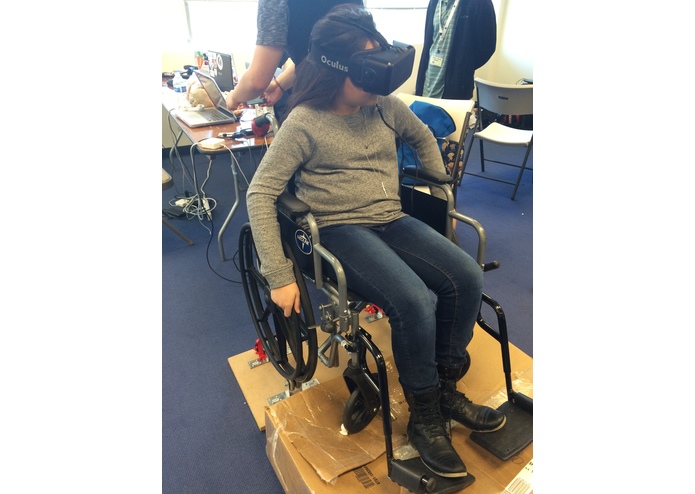Mobility in VR
Pros and Cons for users
- Pro: Users with physical impairments can and do participate in virtual environments
- Pro: Virtual environments can offer users the ability to overcome real world physical barriers
- Pro: Avatars allows users to customise how they present themselves to others. Some users choose an avatar with a wheelchair, others do not: some switch between avatars with and without mobility aids 1
- Con: Users with mobility impairments may have difficulty using input devices such as motion controllers
- Con: Interaction in virtual environments often involves precise click targets
- Con: Users with mobility impairments may have difficulty using head trackers to adjust roll, pitch and yaw
- Con: Users with severe mobility impairments may find locomotion, such as walking or flying, difficult
- Con: Users may have difficulty sensing haptic cues

Haptic Interface
| Cue | Ambient | Object | Movement | Informational |
|---|---|---|---|---|
| Tactile | Atmospheric Wind | Air-conditioning airflow | Movement wind | Directional wind |
| Factory floor vibration | Floor air-conditioning vibration | Footstep vibration | Proximity alert vibration | |
| Kinesthetic | N/A | Force feedback for object collisions | Arm swing | Force feedback from joystick |
Adjusting Head Height
- In VR, headset sensors are used to track head height.
- Accurate head height contributes to the user's sense of immersion.
- Lower head height makes it easier to interact with objects on the floor, but harder to reach objects at table or head height. 3
User interaction from a seated perspective. Animated gif courtesy of Brian Van Buren, Tomorrow Today Labs - Increased head height makes it easier to interact with objects at table height, but may put floor objects out of reach.
User interaction from a standing perspective. Animated gif courtesy of Brian Van Buren, Tomorrow Today Labs
Mobility Use Cases
- As a user with a mobility impairment, I need to be able to adjust time limits, so I can complete tasks.
- As a user with a mobility impairment, I need support for alternative input devices, so that I can interact with the environment.
- As a user with a mobility impairment, I need to be able to remap or reconfigure input controls, so that I can interact with the environment. 4
- As a user with a mobility impairment, I need spacing between interactive buttons and objects, so I can avoid errors.
- As a user with a mobility impairment, I need to be able to adjust the sensitivity of input controls, so I aim accurately. 4
- As a user with a mobility impairment, I need a focus indicator, so I can identify which element has focus.
- As a user with a mobility impairment, I need to be able to interact from a lower head height.
References
Learning in Virtual Worlds: Research and Applications
Citation: Gregory, S., Lee, M.J., Dalgarno, B. and Tynan, B. eds., 2016. Learning in Virtual Worlds: Research and Applications. Athabasca University Press.
Summary: contains an interesting chapter on (In)accessible learning in Virtual Worlds. Much of the conclusions are drawn from Second Life but are still relevant to other VR applications
An initial exploration of a multi-sensory design space: Tactile support for walking in immersive virtual environment.
Citation: Feng, M., Dey, A. and Lindeman, R.W., 2016, March. An initial exploration of a multi-sensory design space: Tactile support for walking in immersive virtual environments. In 2016 IEEE Symposium on 3D User Interfaces (3DUI) (pp. 95-104). IEEE.
Summary: Examines the use of multi-sensory feedback to improve user experience in virtual environments
Accessibility in VR: Head Height
Citation: Brian Van Buren, "Accessibility In VR: Head Height". VRINFLUX. N.p., 2016. Web. 18 July 2016.
Summary: Excellent article comparing interaction from standing and seated perspectives.
Game Accessibility Guidelines
Citation: "Game Accessibility Guidelines | A Straightforward Reference For Inclusive Game Design". Gameaccessibilityguidelines.com. N.p., 2016. Web. 18 July 2016.
Summary: Designed as a reference for game developers, this site offers a detailed list of accessibility guidelines.
Hard Lesson On Leaning On Virtual Desks
Citation: "Hard Lesson On Leaning On Virtual Desks". YouTube. N.p., 2016. Web. 19 July 2016.
Summary: Video of a child struggling to develop spatial awareness in a virtual environment.